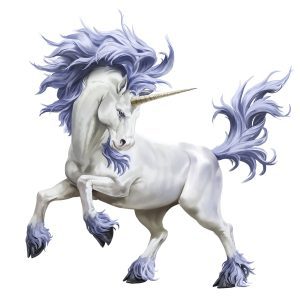
The classic alignment grid consisting of three rows (Good, Neutral, and Evil) and three columns (Lawful, Neutral, and Chaotic) is a contentious topic in TTRPGs. A lot of games (including the Tales of the Valiant RPG) don’t use it, but it endures. Criticisms include that the system is too rigid and is not descriptive enough. And it essentially predestines certain creatures to be either good or evil.
Shortfalls aside, the alignment system leaves an open question: “Why are there good-aligned creatures in monster books?” Kobold Press’s own Tome of Beasts 1 includes several good-aligned creatures. These creatures make fantastic NPCs or allies for the party, but does that mean a party can never fight a buraq or a firebird?
A GM can ignore alignment and have the party fight an “evil” angel. But maybe a better choice is to find interesting narrative ways to make typically “good” creatures antagonists while maintaining their lore.
Catch up on all the goodness you missed—blink dogs, couatls, and more!
Unicorn
Unicorns are one of the most recognizable creatures in fantasy, but because they’re good-aligned, PCs almost never fight them. Unicorns have been depicted as healers, nature guardians, or free spirits of the wild that follow their own call. In almost all stories, unicorns are extremely rare and avoid civilization. So how do you make them the enemy?
In the Blood
In many fantastical worlds, including Harry Potter, a unicorn’s blood holds magical properties that allow it to be used as a reagent for potent magical rituals. Would a basically good-leaning party slay a unicorn for its blood so that it can cast a spell to save thousands of innocents (and their favorite NPCs)?
Sometimes even heroes need to do bad things for the right reasons. A powerful extra-worldly entity can stymie the upcoming apocalypse, but they need fresh blood from a unicorn—a full unicorn’s worth.
In this scenario, you can use the unicorn in the following ways:
- The unicorn is encountered within its lair. If you have the Tales of the Valiant Monster Vault, you can use the unicorn’s full suite of lair actions during the fight.
- If the unicorn is a solo boss, allow it to use its Healing Touch action as a bonus action to help it stay in the fight.
Tainted Wilds
Unicorns are often deeply in tune with the wild nature of their home. But pristine wilds are prone to corruption.
Some magical component of the unicorn’s environment (a sacred pool or tree) has become tainted, and its essence has transferred to the unicorn. The unicorn is combative, even feral.
If the pool or tree becomes purified, the unicorn can be saved from its corruption. In this scenario, you can use the unicorn in the following ways:
- The party’s goal is not to kill the unicorn but rather to save it by purifying the source of its corruption. During the inevitable fight, one or more characters can use their action to try to interact with the corrupted source with a relevant skill (Arcana or Nature) while the unicorn and its corrupted minions attack. After three successful checks, the source is purified and the unicorn becomes nonhostile.
- The unicorn’s Healing Horn action can be replaced with the following bonus action:
- Corrupted Horn. As part of its Horn attack, one creature hit by it each turn must succeed on a DC 14 CON save or become poisoned for 1 minute. While poisoned, the creature takes 4 (1d8) poison damage at the start of its turns, and the unicorn regains an equal number of hit points. At the end of each of its turns, the target can repeat the save to end the effect.
More GM advice and tools are on the way in the Tales of the Valiant Game Master’s Guide!
It completely funded on Kickstarter! If you missed the campaign, there’s still time to pre-order!
GO TAKE A LOOK!

